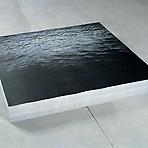Felix Gonzalez-Torres
December 4, 1998 – January 23, 1999
Main Gallery
The first show of Felix Gonzalez-Torres' work after his death seemed to be quite imperative and ideal. In January 1997 we exhibited a single work, "Untitled" (Beginning), 1994 – a primarily green beaded curtain that seemed to both fill the gallery space and dissect it. This was a work Felix had given to me as a gift before he died in January 1996 and I had never seen it installed. It was typically generous of him to predict that I would need this experience even more so after his death. The piece is so joyous, so hopeful, so full of life. Like so much of Felix's work it is a physical manifestation of the knowledge that there is a continuation. Felix's afterlife exists in his ongoing influence. To create a work called "Untitled" (Beginning) at a time when one might have focused on endings was typical of Felix and showing this work set the ground to give me the confidence to find a purposeful way to continue to exhibit his work in the gallery.
This current exhibition, the second since his death, is more ambitious because it is curatorial as opposed to a re-creation of a single piece or pre-existing installation of Felix's making. When I reviewed Felix's catalogue raisonné (published in 1997 by Cantz Verlag for the Sprengel Museum, Hanover) for the first time I was struck by the significance of the first few consecutive pages. Though it is probably the common perception that the paper stack pieces were Felix's first significant works, the catalogue raisonné became a physical record of what Felix considered to be the beginning of his oeuvre. What appears on these first few pages are works that primarily incorporate images of crowds – crowds at baseball games, crowds in parades, cut outs from the newspaper (most likely The New York Times since Felix referred to the newspaper, with slight irony, as his constant source of inspiration). Of course I knew all of these pieces intimately, but seeing them all together, page after page, – I realized just how central these works are. They are the beginning of Felix's investigation of what he considered to be the arbitrary separation between the public and private. I believe that one of Felix's goals was to help break down our feeling of separation from the world around us – or visa versa, our feeling of insignificance if we are not part of something else. I think Felix felt that by addressing these ambiguities we could more readily understand our potential impact as well as our responsibilities.
This exhibition presents the variation of works incorporating crowd images, accompanied by one particular body of stack pieces. Between the years of 1990 and 1991 Felix made four stack pieces, each incorporating newspaper clippings from The New York Times. For me there are numerous reasons for grouping these two bodies of work together. The sheets within each stack become a physical parallel to the individual within the crowd. What is the whole – the single sheet/person or the mass? The text clippings, like the crowd images, emphasize Felix's interest in the reiteration and the recontextualization of information in order to create an implosion of meaning. Both bodies of work also address Felix's relationship to the photograph, the reproduced image. But mostly, this exhibition is a personal indulgence – an opportunity for me to be able to see and experience certain works that I have never seen installed together before. As was most often the case for Felix, a gallery exhibition was an opportunity to see his own work physically manifested for the first time.
-Andrea Rosen







